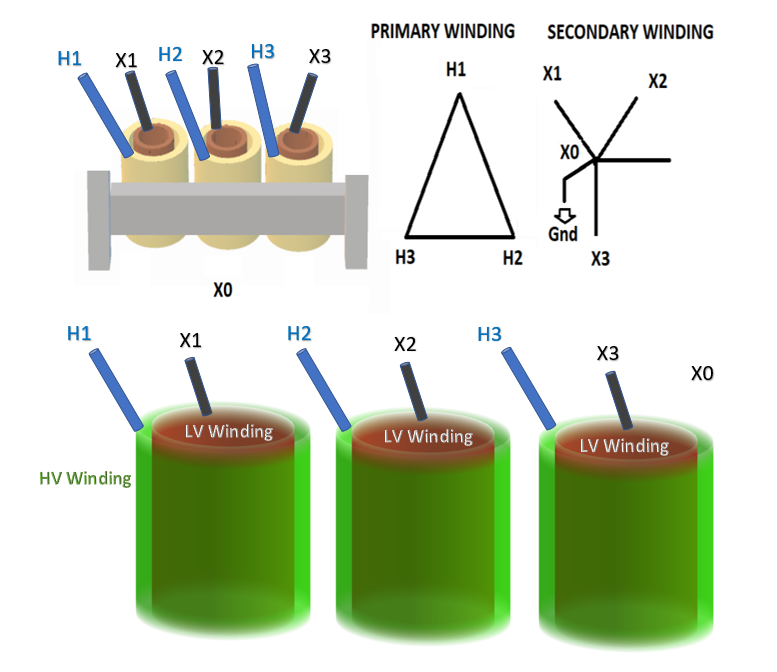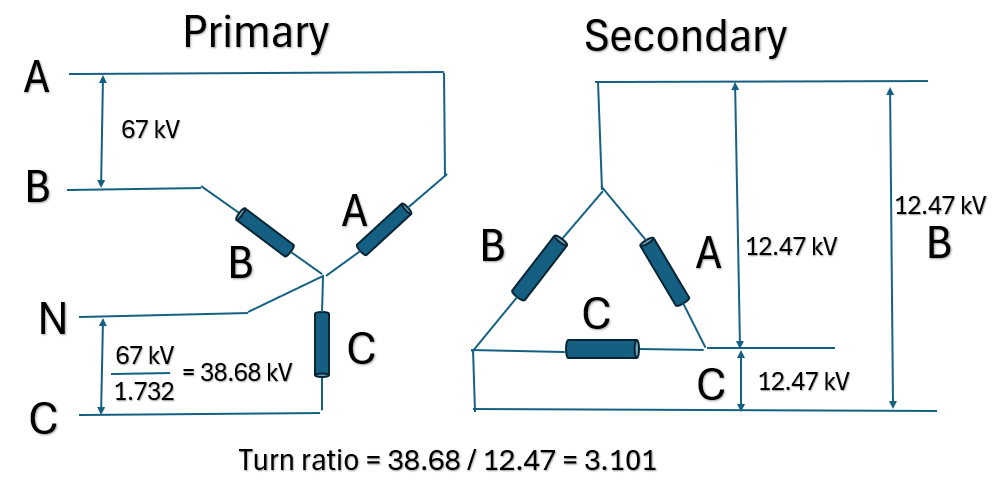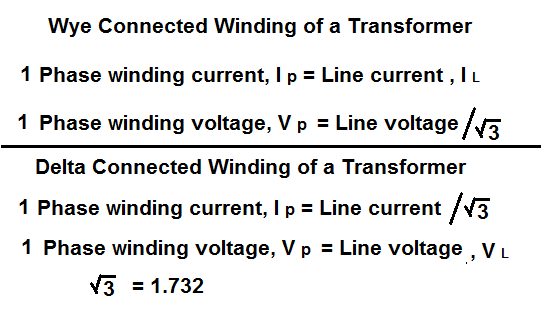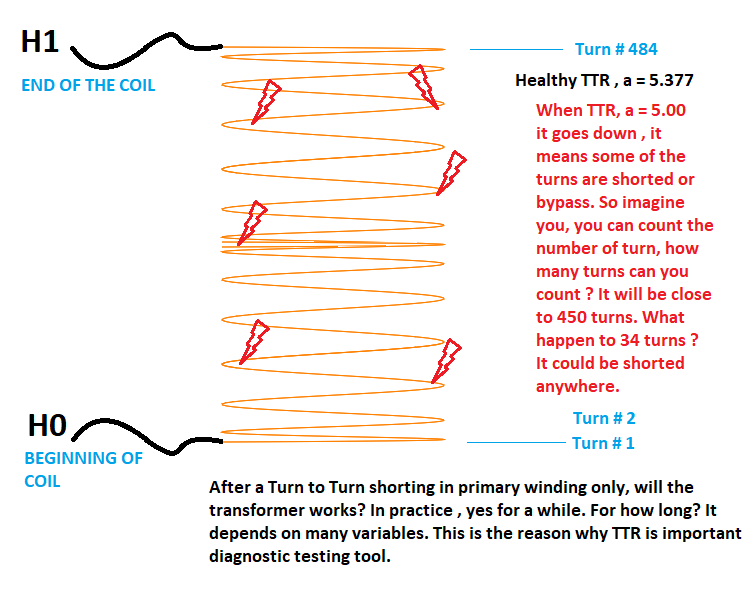Never Forget Again

















🎯 NEVER FORGET.
Every solved problem becomes trusted automation—saving you time, reducing stress, and helping you make smarter decision faster.
Subscribe now—because your memory deserves a backup.
$120 per school per year
click to read more
Use AI voice-to-text: type or speak your query then tap SEARCH 2
Transformer Turn Ratio Calculator
The above formula is valid for a single phase transformer. When you have bank of three - single phase transformer into delta wiring configuration or wye wiring configuration to get three phase transformer bank, don't forget the √ 3 in calculating turn ratio





Usually the LV winding has less turn of coils but bigger cross sectional area because it carries a lot of current and installed close to laminated steel core. The HV winding has more turn of coils but smaller cross sectional area because it carries less current. For sample calculation go to problem #6 below.
For a three phase transformer, the single phase voltage ratio is not always equal to the three phase voltage ratio, you need to know what is the primary winding and secondary winding configuration.
For delta - wye winding configuration, the multiplying factor for single phase voltage ratio is 1.732*[67/12.47] = 9.306 to get the equivalent calculated three phase voltage ratio as shown
by the above circuit model. For wye - delta winding configuration, to get the equivalent three phase voltage ratio, just divide the delta - wye calculated value by 1.732
Modern Transformer Turn Ratio (TTR) test instrument are using software lookup table to find the correct multiplying factor depending on specified winding configuration entered during Transformer Turn Ratio (TTR) testing session.
It is a good practice to review the TTR test instrument winding configuration setting and make sure it is the same with the transformer winding configuration shown on the transformer nameplate.
Factory test report calculated value for three phase transformer voltage ratio can be evaluated using single phase voltage ratio multiplied by a factor based on winding configuration.
TTR should be a part of a good routine preventive maintenance program as well as for acceptance testing.
Shown below are the single phase multiplying factor based on transformer winding connection to convert line to phase voltage or current.

The De-Energized Tap Changer (DETC) of a 3 phase power transformer was set at primary voltage of 67 kV and the OnLoad Tap Changer (OLTC) at secondary winding is set at 13.75 kV as the rated voltage also called the secondary voltage. If you look at transformer nameplate, the neutral voltage is indicated by letter "N"; Calculate the Voltage Ratio at the given DETC & OLTC tap settings. This voltage ratio or turn ratio is your baseline value for a healthy transformer with respect to normal winding turn to turn ratio. If there is no turn to turn short circuit on your primary windings or secondary windings the voltage ratio value or turn ratio value should remained very close to your voltage ratio baseline value. Assuming that the instrument was properly calibrated.
Problem #1, Valid for 3 Φ , Δ - Y only, using voltage measurement to solve for turn ratio
|
turn ratio =
|
= |
Δ, kV Primary * 1.732
Y , kV Sec. Voltage
|
For 3 Φ , Y - Δ the turn ratio is
Δ - Y turn ratio / √ 3 =
/ 1.732 = 3.101




This automated and assistive intelligence is one example of IN-V-BAT- A.I. useful immediately to students, teachers, employees, and employer to help them save time and money.
If your primary winding is starting arcing or shorting due to dielectric paper or oil insulation breakdown, you will expect to have a trending of lower turn ratio (a) in your TTR measurement
compare to factory test report. It is also indicated by primary voltage reading trending towards lower value. Lower your primary voltage from 67 kV to 49 kV.
This will lower your turn ratio from normal value of 9.306 to abnormal value of 6.806 (a = 6.806). When you notice your primary voltage trending down to 49 kV it
could be a good indicator for possible primary winding is developing a shorted turn to turn winding condition.
If your secondary winding is shorted, your secondary voltage will be lowered from baseline. For example, secondary voltage baseline is 12.47 kV. Lower it to 11 kV.
The turn ratio will increase to 10.55. Conclusion if the turn ratio is decreasing it is an indicator of primary winding is experiencing turn to turn fault. If the turn ratio is
increasing from the baseline value it is an indicator of secondary winding is experiencing turn to turn fault.
Remember the fundamental principle that induced voltage is directly proportional
to frequency and number of turns of coil conductors in HV and LV windings. if your winding turn number (N) value is trending downward because of turn to turn shorting, then your voltage
measurement will be your confirmation evidence. The fundamental physics principle of induced voltage says if your number of turns of your winding coils is decreasing due to turn to turn fault,
then you must expect to see the induced voltage to go down also.
V ∞ f * N [ induced voltage is directly proportional to frequency and number of coil turns ]
Problem #2, Valid for 3 Φ , Δ - Y only
Given three phase turn ratio 9.306 and Secondary voltage 12.47 kV; Calculate the expected primary voltage
|
three phase turn ratio, a
|
= |
kV Primary Voltage * 1.732
kV Secondary Voltage
|
Click white input box to enter new number


If your secondary winding is shorted, you will expect to have a higher turn ratio (a) in your TTR measurement compare to factory test report. It is also indicated by lower secondary voltage reading.
Use the calculator below to do simulation. What will happen to your secondary voltage if your TTR reading goes up to 11.521? What will happen to your secondary voltage if your TTR reading
goes down to 5? Turn ratio value is dependent on your transformer tap setting. If your transformer has onload tap changer, your transformer turn ratio has a certain acceptable design range.
Problem #3, Valid for 3 Φ , Δ - Y only
Given a three phase turn ratio 9.306 and Primary voltage 67 kV; Calculate the expected secondary voltage
|
three phase turn ratio, a
|
= |
* 1.732 Primary Voltage
Secondary Voltage
|
Click white input box to enter new number


Knowing the factory report of voltage ratio (TTR) of the above 3 phase transformer as 9.306 your baseline for a healthy condition, what do you think happen to the same transformer if the voltage ratio (TTR) from the latest test report is 7.3163 ? Can you estimate the coil location of the Turn to Turn winding short? Can you tell which side of the winding (HV or LV) the Turn to Turn winding short happen? Can you make a generalization about the location of the turn to turn winding short if the TTR test report value is less than the baseline TTR value?
Problem #4, Valid for 1 Φ only or 3 Φ Y-Y or 3 Φ Δ - Δ
Given single phase voltage ratio of 4.8727 and Secondary voltage 13.75 kV; Calculate the expected primary voltage
|
Voltage Ratio, a , single phase
|
= |
Primary Voltage
Secondary Voltage
|
Click white input box to enter new number


Problem #5, Valid for 1 Φ only or 3 Φ Y-Y or 3 Φ Δ - Δ
Given Turn Ratio, a , single phase 5.333 and Primary voltage 69 kV; Calculate the expected secondary voltage
|
Turn Ratio, a
|
= |
Primary Voltage
Secondary Voltage
|
Click white input box to enter new number


Assuming from your transformer design review you learned that the primary coil winding turns is 484 for 67 kV tap setting on your DETC and the secondary coil winding turns is 90 to get 12.47 kV and set at Neutral tap setting on your OLTC. Calculate your transformer turn to turn ratio using the given number of turns as your baseline for a healthy condition.
Problem #6, Valid for 1 Φ only or 3 Φ Y-Y or 3 Φ Δ - Δ
Given primary coils number of turns = 484 and secondary number of turns = 90
Given primary voltage 525 kV and secondary voltage 230 kV ; 3 Φ Y-Y
Calculate the expected Turn to Turn Ratio (TTR).
|
Turn Ratio, a , single phase
|
= |
Primary coils number of turns
Secondary coils number of turns
|
Click white input box to enter new number


Problem #7, Valid for 1 Φ only or 3 Φ Y-Y or 3 Φ Δ - Δ
Given Turn ratio = 5.3778 and Secondary number of turns = 90; Calculate the expected primary number of turns of coil. Now assuming your TTR value a = 5.00, what is the expected number
of turns now in primary winding? How many coil turns have been bypass or short circuited from original 484 turns? Is it possible to locate where they are in your primary winding? Possibly
with acoustic triangulation methods of diagnostic.
|
Turn Ratio, a , single phase
|
= |
Primary coils number of turns
Secondary coils number of turns
|
Click white input box to enter new number


Problem #8, Valid for 1 Φ only or 3 Φ Y-Y or 3 Φ Δ - Δ
Given Turn Ratio, a , single phase = 5.3778 and Primary number of turns = 484; Calculate the expected secondary number of turns of coil. How can you tell if the turn to turn short circuit
happen in primary winding? Answer, usually if the turn ratio value goes down from the baseline value. For example the baseline value of a = 5.3778 then it goes down to 5.00 what will happen
when you enter new value by changing the value of 5.3778 to 5.00? The secondary coil number of turns goes up to 96.8 from original coil turn number of 90. At this point, you know immediately
the short circuit happens in the primary winding. How? Because you can't add additional turn in your existing secondary transformer coil. It's number will always stay at 90 turns of coil if nothing
is shorted on the secondary winding. Now you know the fault happens in primary winding, try changing the number of turns of your primary coil winding until the value of your secondary coil turns is 90.
Try 450, you should get 90 on your secondary coil turns. At this time you do the math and you know there were 34 turns in your primary winding that was compromised. It's location could be anywhere in the primary winding side. VERY IMPORTANT: YOU SHOULD BE CAREFUL IF YOUR HAVE DE-ENERGIZED TAP CHANGER (DETC) OR LOAD TAP CHANGER (LTC) because there is a possibility that the tap settings are changed and it will result in different turn ratio. You should have a baseline record of turn ratio at different tap setting.
|
Turn Ratio, a , single phase
|
= |
Primary coils number of turns
Secondary coils number of turns
|
Click white input box to enter new number


Problem $9, Valid for 1 Φ only or 3 Φ Y-Y or 3 Φ Δ - Δ
Given Secondary FLA = 1296.41 and Primary FLA = 241.28;
Given Primary voltage = 525 kV and Secondary = 230 kV ; 3Φ Y - Y
Calculate the expected turn ratio
|
Turn Ratio, a , single phase
|
= |
Secondary current
Primary current
|
Click white input box to enter new number


Problem #10, Valid for 1 Φ only or 3 Φ Y-Y or 3 Φ Δ - Δ
Given Turn Ratio, a , single phase = 5.3778 and Primary FLA = 241.28; Calculate the expected secondary full load ampere (FLA)
|
Turn Ratio, a
|
= |
Secondary current
Primary current
|
Click white input box to enter new number


Problem #11, Valid for 1 Φ only or 3 Φ Y-Y or 3 Φ Δ - Δ
Given Turn Ratio, a , single phase = 5.5334 and Secondary FLA = 1296.41; Calculate the expected primary full load ampere (FLA)
|
Turn Ratio, a
|
= |
Secondary current
Primary current
|
Click white input box to enter new number


Problem #12, Valid for 3 Φ only
Given 3 Phase MVA rating = 28 and Secondary voltage = 69 kV; Calculate the expected primary full load ampere (FLA)
3 Phase MVA RATED POWER TRANSFORMER
|
Primary, Amp
|
= |
3 Phase MVA Rating
Primary kV * 1.732
|
Click white input box to enter new number


Problem #13, Valid for 3 Φ only
Given Secondary FLA = 1296.41 and Secondary voltage = 12.47 kV; Calculate the expected 3 Φ MVA rating of transformer
|
Secondary, Amp
|
= |
3 Phase MVA Rating
Secondary kV * 1.732
|
Click white input box to enter new number


Problem #14, Valid for 3 Φ only
Given 3 phase kVA = 1000 and Primary voltage = 480; Calculate the expected primary full load ampere (FLA)
3 Phase KVA RATED POWER TRANSFORMER
|
Primary, Amp
|
= |
3 Phase kVA Rating
Primary V * 1.732
|
Click white input box to enter new number


Problem #15, Valid for 3 Φ only
Given Secondary FLA = 2405.70 and Secondary voltage = 240; Calculate the 3 Φ kVA rating of transformer
|
Secondary, Amp
|
= |
3 Phase kVA Rating
Secondary V * 1.732
|
Click white input box to enter new number


Problem #16, Valid for 3 Φ only
Given Primary FLA = 1202.85 and 3 phase kVA = 1000; Calculate the expected primary voltage
|
Primary, Amp
|
= |
3 Phase kVA Rating
Primary V * 1.732
|
Click white input box to enter new number


.
IN-V-BAT-AI helps you recall information on demand—even when daily worries block your memory. It organizes your knowledge to make retrieval and application easier.
Source: How People Learn II: Learners, Contexts, and Cultures
.
How can IN-V-BAT-AI be used in classrooms ?
IN-V-BAT-AI is a valuable classroom tool that enhances both teaching and learning experiences. Here are some ways it can be utilized:
⋆ Personalized Learning : By storing and retrieving knowledge in the cloud, students can access tailored resources and revisit
concepts they struggle with, ensuring a more individualized learning journey.
⋆ Memory Support : The tool helps students recall information even when stress or distractions hinder their memory, making it
easier to retain and apply knowledge during homework assignments or projects.
⋆ Bridging Learning Gaps : It addresses learning loss by providing consistent access to educational materials, ensuring that
students who miss lessons can catch up effectively.
⋆ Teacher Assistance : Educators can use the tool to provide targeted interventions to support learning.
⋆ Stress Reduction : By alleviating the pressure of memorization, students can focus on understanding and applying concepts,
fostering a deeper engagement with the material.
🧠 IN-V-BAT-AI vs. Traditional EdTech: Why "Never Forget" Changes Everything
📚 While most EdTech platforms focus on delivering content or automating classrooms, IN-V-BAT-AI solves a deeper problem: forgetting.
✨Unlike adaptive learning systems that personalize what you learn, IN-V-BAT-AI personalizes what you remember. With over 504 pieces of instantly retrievable knowledge, it's your cloud-based memory assistant—built for exam prep, lifelong learning, and stress-free recall.
- ✅ One-click access to formulas, calculators, and concepts
- 📧 No coding, no hosting—just email what you want to remember
- 📱 Live within 24 hours, optimized for mobile and voice search
- 💸 $30/year for 504 personalized knowledge sites (just 6¢ each)
"🧠 Forget less. Learn more. Remember on demand."
That's the IN-V-BAT-AI promise.
Personal Augmented Intelligence (AI) Explanation
🧠 Augmented Intelligence vs Artificial Intelligence
Understanding the difference between collaboration and automation

🔍 Messaging Contrast
Augmented Intelligence is like a co-pilot: it accelerates problem-solving through trusted automation and decision-making, helping you recall, analyze, and decide — but it never flies solo.
Artificial Intelligence is more like an autopilot: designed to take over the controls entirely, often without asking.
💡 Why It Matters for IN-V-BAT-AI
IN-V-BAT-AI is a textbook example of Augmented Intelligence. It empowers learners with one-click recall, traceable results, and emotionally resonant memory tools. Our “Never Forget” promise isn't about replacing human memory — it's about enhancing it.

Note: This is not real data — it is synthetic data generated using Co-Pilot to compare and contrast IN-V-BAT-AI with leading EdTech platforms.


.
.
.
🎉 60,000 Visitors 10/24/25
IN-V-BAT-AI just crossed 60,000 organic visits—no ads, just curiosity and word-of-mouth.
Every visit is a step toward forgetting less, recalling faster, and remembering on demand.
Never Forget. Learn on demand.
🔗 SubscribeTry AI website hosting
$30 per year
| Year | Top 10 countries | Pages visited |
| 2023 | 1. USA 2. Great Britain 3. Germany 4. Canada 5. Iran 6. Netherlands 7. India 8. China 9. Australia 10. Philippines | 127,256 Pages / 27,541 Visitors |
| 2024 | 1. USA 2. China 3. Canada 4. Poland 5. India 6. Philippines 7. Great Britain 8. Australia 9. Indonesia 10. Russia | 164,130 Pages / 40,724 Visitors |
| Daily Site Visitor Ranking 10/26/2025 | 1. USA 2. Canada 3. Brazil 4. Vietnam 5. China 6. India 7. Argentina 8. Japan 9. Morocco 10. Indonesia | Year to Date 178,030 Pages / 60,375 Visitors |
Data source: Advanced Web Statistics 7.8
Approximately between 2.3 and 2.5 million schools globally, according to the latest available data from government and education ministry reports.
🔗 The challenges schools face: 2025/2026 🔗 USA ~ Public 98,500 ~ Private 30,000 ~ Total 128,500 🔗 Canada ~ Public 15,500 ~ Private 2,000 ~ Total 17,500 🔗 Brazil ~ Public 138,000 ~ Private 40,000 ~ Total 178,000 🔗 Vietnam ~ Public 42,000 ~ Private 8,000 ~ Total 50,000 🔗 China ~ Public 217,200 ~ Private 152,800 ~ Total 470,000 🔗 India ~ Public 1,022,386 ~ Private 335,844 ~ Total 1,358,230 🔗 Japan ~ Public 30,240 ~ Private included ~ Total 30,240 🔗 Morocco ~ Public 20,600 ~ Private 6,300 ~ Total 26,900 🔗 Indonesia ~ Public 390,718 ~ Private included ~ Total 390,718 🔗 Philippines ~ Public 47,831 ~ Private 13,000 ~ Total 60,831 Great Britain ~ Public 29,202 ~ Private included ~ Total 29,202 🔗 Australia ~ Public 9,653 ~ Private included ~ Total 9,653 🔗 Russia ~ Public 39,070 ~ Private included ~ Total 39,070 🔗 Germany ~ Public 31,039 ~ Private included ~ Total 31,039 🔗 Poland ~ Public 36,291 ~ Private included ~ Total 36,291 🔗 Iran ~ Public 80,000 ~ Private included ~ Total 80,000 🔗 France ~ Public 58,100 ~ Private included ~ Total 58,100 🔗 Mexico ~ Public 132,505 ~ Private included ~ Total 132,505









